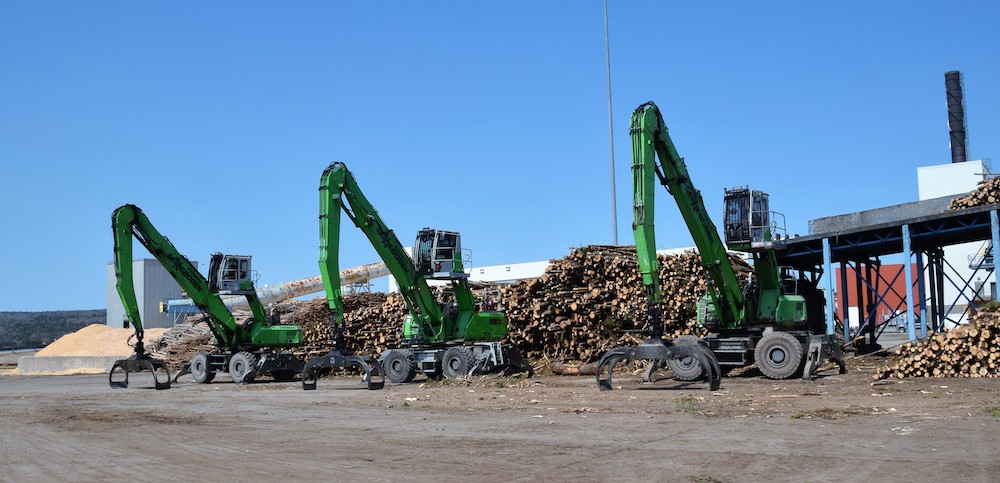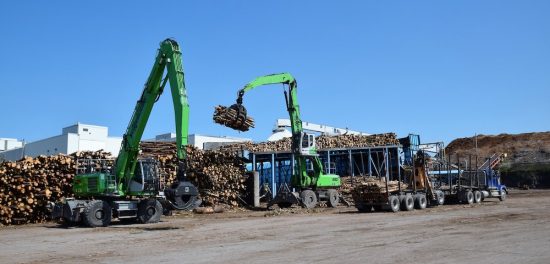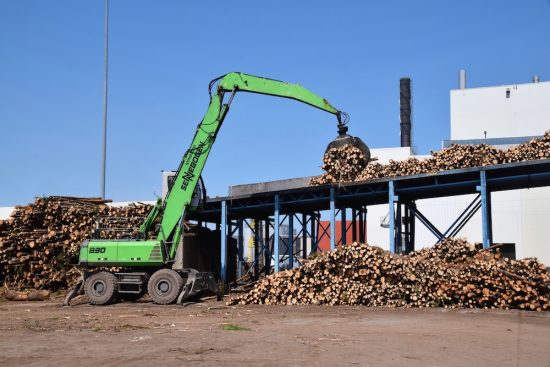
Features
Equipment & Systems
Paper
Port Hawkesbury Paper invests in log handling equipment
The Nova Scotia mill adds its third purpose-built log handler from SENNEBOGEN
July 12, 2021 By SENNEBOGEN
 Port Hawkesbury Paper recently added a third SENNEBOGEN log handler to its fleet after the first two accumulated a total of 100,000 service hours. Photo: Blair Landry/Port Hawkesbury Paper
Port Hawkesbury Paper recently added a third SENNEBOGEN log handler to its fleet after the first two accumulated a total of 100,000 service hours. Photo: Blair Landry/Port Hawkesbury Paper The Port Hawkesbury mill site has a long history of positive contribution to the eastern region of Nova Scotia.
The mill was first developed in 1962 as a sulfite pulp mill and expanded into manufacturing newsprint and pulp for the next three decades.
In 1998, the Port Hawkesbury site expanded again by investing in a state-of-the-art supercalender (SC) paper machine. In 2012, the mill at Port Hawkesbury was reopened by Stern Partners as Port Hawkesbury Paper (PHP) and today continues to operate as a high-tech paper manufacturing facility.
According to Mark Farrow, mechanical maintenance planner and supervisor at PHP who has been on the site since the reopening, the same can be said of the mill’s wood yard.
In 2012, when Stern Partners purchased the mill, they reopened it with $5 million worth of new processing equipment and facility upgrades.
One of the upgrades was a new live-log deck. Loading heights averaged over 22 ft (7 m), beyond the reach of their legacy log-handling machines. The need for higher loading capability led the mill to its first SENNEBOGEN 830 M-T purpose-built log handler.
A machine that can “do it all”
The 830 M-T quickly proved its value, loading directly from incoming trucks up to the feed deck. The elevating Maxcab brought the operators’ eye-level up above the deck for a clear view into their work zone.
With its specially designed undercarriage, the log-handler also came through with the strength to fill and pull 80,000 lb. trailer-loads up and down a 40-foot (12-m) rise to the site’s upper wood yard.
The 830 could do it all, without relying on other machines to help it stack, load, or pull. In due course, as the mill’s success led to full production and round-the-clock shifts, a second 830 M-T was added to the yard fleet.
Port Hawkesbury now represents about 20 per cent of North America’s capacity for SC papers, capable of delivering 400,000 tons of SCA++, SCA+ and SCA papers annually.
Recently, Port Hawkesbury Paper commissioned its third 830 M-T. And that first unit, purchased almost nine years ago, is still on the job.
“This is a tough machine,” Farrow says.
“It’s mechanically sound and gives us great runnability for our operation. The first one is up to 58,000 hours now. Our technicians gave it a new engine two years ago, at 42,000 hours. It was still working fine; we just wanted to be proactive and head off any risk of it going down. We didn’t want to be down to one machine.
“Now the second unit is up close to 48,000 hours – and it has a new engine, too. It’s quite the machine, all around.”

Mark Farrow credits his team of factory-trained technicians for the long life and reliability of his log-handling fleet. Photo: Blair Landry/Port Hawkesbury Paper
The secret to machine longevity
Farrow says that the only time his 830s stop is when they have to refuel. Between unloading trucks, feeding the deck, and picking logs from the stockpile, the 830s are always moving all over the yard.
Conditions can be difficult, and he says, “Some spots can get wet; it’s rough; there are slight hills in the yard. But we’ve never had an issue with towing anything anywhere in the yard. They handle everything we throw at them.”
Based on SENNEBOGEN’s material handler platform, the undercarriage of the 830 M-T is specially engineered for the stresses of log yard duties. Reinforced to handle heavy pulling stresses, it also features dual transmissions, serving each axle to pull through muddy spring yard conditions and challenging grades.
But Farrow says the secret to his machines’ longevity is the people who look after the machines.
“We have four service techs on staff who keep them running efficiently,” he explains. “These guys are professionals at what they do, and all work as a team. The techs here are very involved in the operation and are a key factor in why these machines keep running the way they do.”
Factory training builds trust
All four techs on the service team have completed SENNEBOGEN’s weeklong “Level 1” factory training program, provided at no cost at the firm’s training centre in Stanley, N.C.
Plans were in place for them to also attend the Level 2 training school for advanced troubleshooting, however, COVID-19 forced a postponement. According to Farrow, it is on the books to reschedule the training as soon as possible, but that the team is currently “highly skilled and self-reliant.”
“We use the Computerized Maintenance Management System Avantis at PHP,” he says. “They know the system, they know the equipment, they’re computer savvy. They monitor all PMs and control the work order flow. Along with all the other equipment, they keep things in order and enter important data when closing work orders for future reference.”
Farrow also credits the strong working relationship between the technicians and the operators in the yard.
“Our operators have respect for their equipment. They take good care of the machines. They report to the operations manager at the end of every day, so any little thing that comes up, the techs can pick it off quickly. The technicians and operators all know each other, too. They are in touch using two-way radios. If there’s something the operator needs looked at right away, one of the techs can get into the service truck and look after it right onsite.”

The ability to safely feed a new 22-ft high loading deck was a key factor in the decision to switch to purpose-built SENNEBOGEN log handlers. Photo: Blair Landry/Port Hawkesbury Paper
Design for parts availability
Located on Cape Breton Island, Port Hawkesbury’s only connection to the Canadian mainland is through a causeway landing 7.4 kilometres (five miles) up the road. However, the mill has had no problem ensuring that technicians have a steady supply of parts.
“We have a good relationship with all the people at Strongco (SENNEBOGEN’s authorized dealer in the Canadian Maritimes). We keep a lot of parts here in our own inventory. We stock the service kits that SENNEBOGEN packages up for our machines,” says Farrow.
“SENNEBOGEN also uses a lot of standard, non-proprietary parts that we can buy locally. Even our hoses: we get them made up locally and coded for each machine, and we can make some of them here in our shop. When we planned to exchange the engines, they were here quickly; only a week out, and they could have been faster if we had needed them.”
The next generation
Last year, the management team decided to bring a third SENNEBOGEN 830 M-T to the wood yard. Based on results with the first two SENNEBOGENs, there was never a question of which new log-handler to purchase. “The techs are so familiar with these machines; they can hear a noise from the machine when they’re walking across the yard, and they know what’s wrong,” says Farrow.
This is Port Hawkesbury’s first machine in the new E-Series lineup. “The big change is in cab comfort,” says Farrow. The operators really like it. They can work comfortably whether they are up high or down low, moving or loading through long shifts.
“We’re saving with the new Cummins T4F engines, as well. SENNEBOGEN’s Eco Mode reduces the RPMs automatically to save fuel when they’re idling.”
Print this page